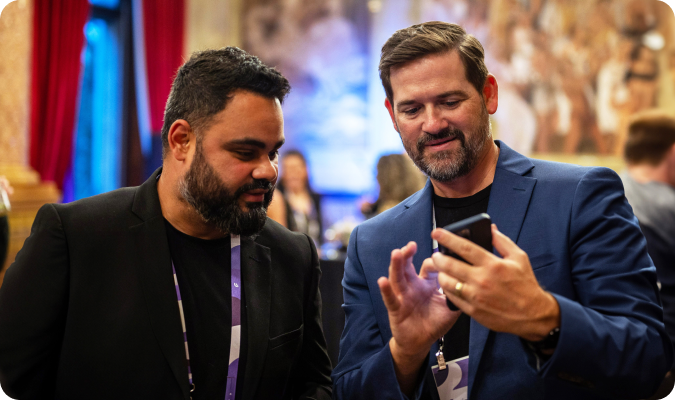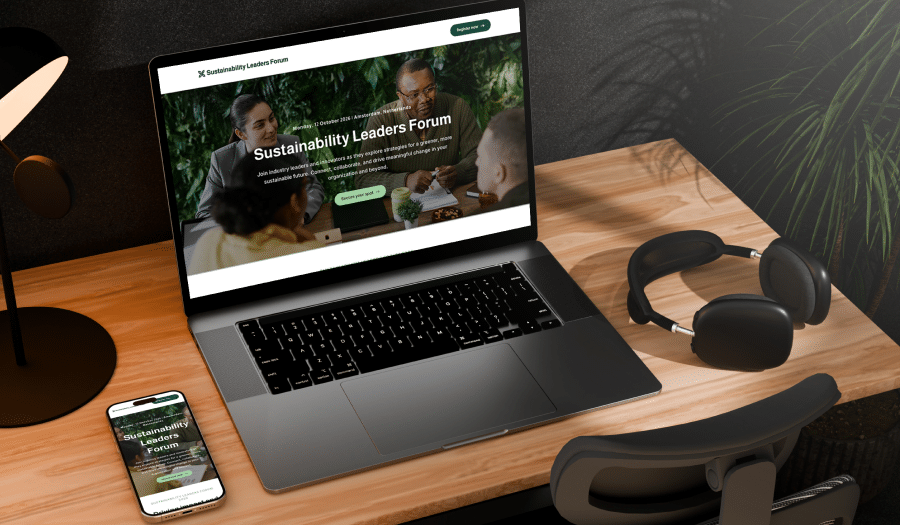
A well-crafted conference agenda is the backbone of a successful event. It sets the tone for the entire conference, guides planning and execution, and ultimately plays a massive role in determining the success of your event.
There’s a lot to manage when planning a conference agenda but with the right approach (and tools) the process can be streamlined and stress-free. In this EventsAir guide, we’ll walk you through the steps to creating a conference agenda that not only works—but wows.
What is a conference agenda?
A conference agenda is a detailed outline of the events and activities scheduled for a conference. It serves as a guide for attendees, helping them navigate sessions, workshops, and networking opportunities throughout the event.
A conference agenda typically has:
- Session titles and descriptions: Each session is listed with its title and a brief description so the attendees know what to expect.
- Timing: Each session includes specific start and end times so that attendees can manage their time effectively.
- Speakers: Information about the speakers or facilitators for each session is provided, along with their credentials and areas of expertise.
- Location: Specifies where each session will take place, which is especially important for larger conferences held in large venues, or across multiple buildings.
- Registration information: You may have details about how to register for different sessions or workshops.
How to create an effective conference agenda
1. Define your objectives
Planning a conference agenda is much more than just a scheduling exercise (although that is an important element). It’s about designing a purpose-built event to achieve your and your attendees’ objectives.
So, you need to start with a deep understanding of both.
Defining your objectives is generally pretty simple. To understand what attendees want from the event, you need data. If you’ve run similar events in the past, analyze the data to see what sessions, speakers, and activities were most successful.
Additionally, review post-event feedback from previous conferences and pay close attention to suggestions from attendees regarding changes they’d like to see in content or agenda structure. An empathetic approach to understanding your attendees’ needs and desires will lead to better events.
2. Plan a budget and select a venue
Next, it’s important to plan your budget and choose a venue.
Your budget influences your agenda by determining the kinds of speakers, activities, and accommodations you can afford. Your venue influences the kinds of activities and experiences you can offer attendees and the number of concurrent sessions you can hold.
Check out our in-depth guide to event budgeting for a deep dive.
3. Plan your sessions
Decide what types of sessions you want to host at the event. These can include:
- Keynote sessions featuring prominent speakers
- Panels where experts discuss trending topics
- Interactive workshops for participants to engage and learn
- Breakout sessions for smaller group discussions and networking
- Plus, any unique session styles that may be relevant to your industry or audience
For each type of event, note down the amount of time and the kind of space you’ll need. For example, a keynote speaker typically needs at least 1 hour of stage time in an auditorium, while a workshop may only need 45 minutes in a smaller room.
For academic conferences accepting abstracts, timing requirements are especially important. Use abstract management software to streamline submission, review, and scheduling—and reduce the risk of errors and late submissions.
Pro tip—having a diverse mix of time and venue requirements makes planning much easier. When you have a 30-minute gap to fill, you can easily slot in a panel discussion or an impromptu networking session.
4. Create a timeline
Timing is crucial to the success of your conference.
Start by working out the total amount of time you have available for your conference. Then, work out how much time is taken up by essential tasks like registration, breaks, and meals. This will give you a clearer idea of how much time you have for conference content.
Then, create a rough timeline by adding sessions from your list to a calendar. Consider the flow of your conference and make sure sessions are scheduled roughly according to expected attendance (not everyone is an early bird).
Beyond simply allocating time for each session, we recommend adding buffer times to allow for delays, room changes, and networking. Starting sessions on the quarter-hour can help attendees mentally reset and easily navigate between rooms.
5. Select your speakers
Now, you can start identifying potential speakers to fill the available slots. Choose speakers who align with your conference objectives and audience, and make sure you plan for alternates in case some of your speakers need to cancel.
To simplify this process, create a dedicated speaker registration flow and use that to collect and organize information. With EventsAir’s presenter and speaker management tools, you can collect upfront information about session preferences, time requirements, and more to make agenda creation easier.
6. Plan for engagement
Engagement is key to a successful conference. Include opportunities for networking, interactive sessions, and other activities that encourage attendee participation. Think about how you can create environments—both formal and informal—where meaningful connections can be made.
For example, you can encourage attendees to use EventsAir’s Attendee App to schedule meetings and connect with peers. This improves attendee engagement and generates valuable networking data for post-event analysis. Plus, our gamification features keep energy levels high and encourage friendly competition.
Also, consider adding targeted networking sessions to your agenda—think “Exclusive VIP Breakfast” or “First-Time Attendee Meet & Greet”. You can set the visibility of these sessions to specific groups to create targeted networking opportunities and boost satisfaction.
7. Review and revise
It’s critical to have a second (or third) set of eyes review the agenda—especially for complex, multi-track events. Gather feedback from both your internal team and a few key stakeholders to ensure nothing is overlooked. We recommend conducting a “dry run” of the agenda with your team to work out any timing conflicts.
And if there are conflicts? Having an adaptable event management platform is a must. With EventsAir, any last-minute agenda changes can be immediately reflected on all attendee-facing platforms, including:
- Apps
- Websites
- Emails
- Integrated tools
That means fewer rushed adjustments that increase the risk of errors, typos, etc.
8. Communicate clearly
Clear communication with all stakeholders—attendees, speakers, sponsors, and staff—is essential.
Ensure that everyone knows what to expect and when. Share your finalized agenda using multiple channels, including your event website, emails, and mobile apps, to ensure that everyone has access to the most current information.
And don’t stop communicating during the event. Create segmented groups of attendees and send targeted messages highlighting sessions they might be interested in, special events, and other important updates.
9. Gather feedback
After the event, it’s important to gather feedback from attendees to learn what worked well and what could be improved. Be deliberate about this—collect targeted session feedback to assess how your agenda was perceived.
This feedback will be invaluable for planning future events, helping you to refine your approach and enhance the attendee experience.
Conclusion
Creating an effective conference agenda requires careful planning. And with EventsAir, you can significantly streamline this process.
From managing speakers and sessions to providing real-time updates and feedback, we have everything you need to create a successful conference agenda. Request a demo and see how EventsAir can transform your next conference.
Attendee Experience | Best Practice
See EventsAir in action
Discover why 12,000+ event professionals trust EventsAir to deliver effortless events, every time.




